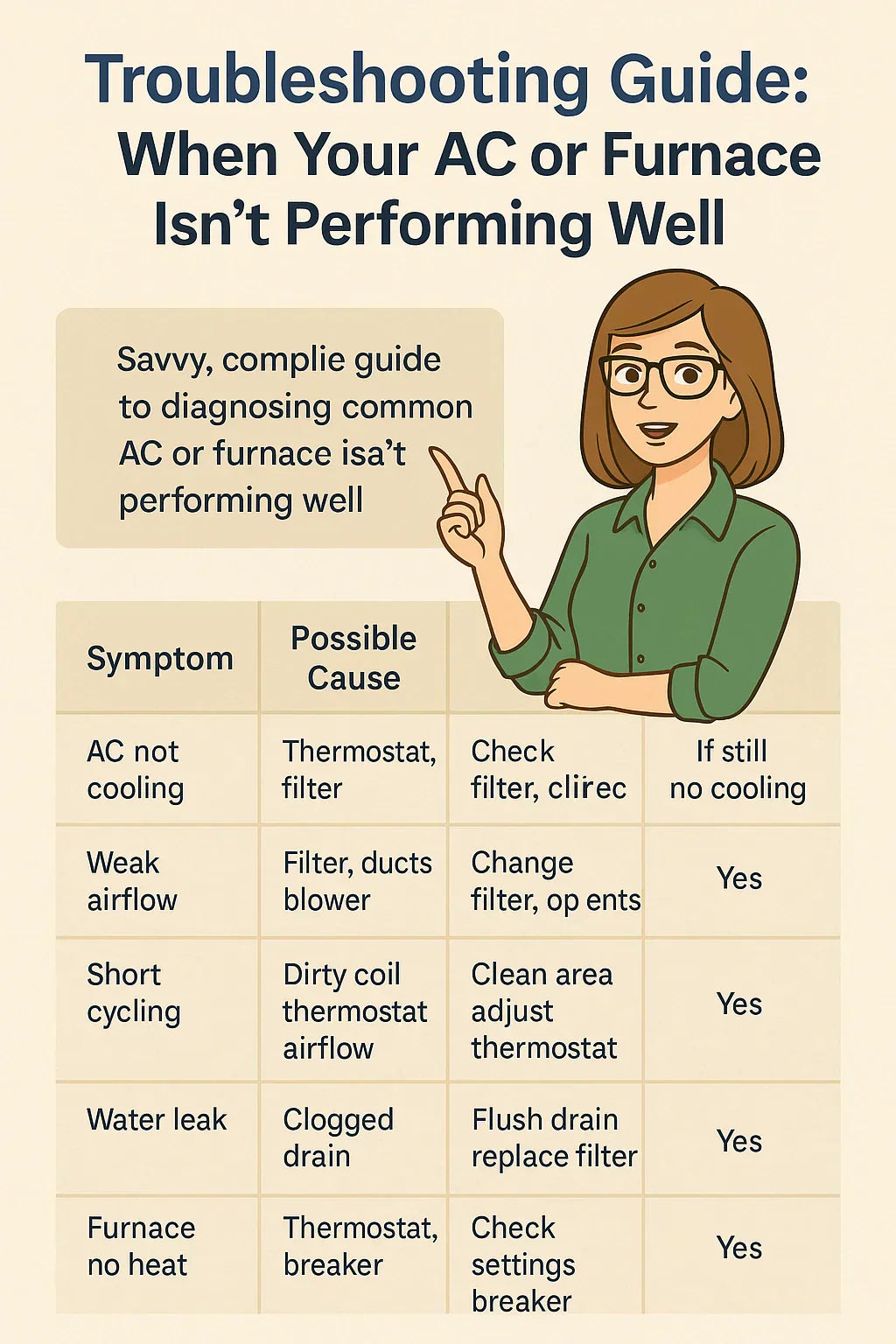1. Introduction – Don’t Panic, Get Savvy
Hey, it’s Savvy here.
I’ve been in plenty of homes where the air conditioner or furnace was acting up, and the homeowner was already picturing the worst: expensive repairs, total replacement, weeks without comfort.
Here’s the truth — a lot of HVAC performance issues are caused by simple things you can check yourself before calling in a pro.
This guide will give you:
-
Clear, step-by-step troubleshooting tips for both AC and furnace systems
-
DIY-friendly checks you can safely do at home
-
A quick-reference symptom table to make problem-solving easy
-
Guidance on when to call a professional
By the time you finish, you’ll know how to confidently assess the situation and decide your next step.
2. First Things First – Safety Checks
Before touching anything, safety comes first.
Turn Off Power
-
For AC: Shut off power at the outdoor disconnect AND the indoor breaker.
-
For furnace: Turn off the switch near the furnace and shut off the breaker.
Gas Furnace Safety Precautions
-
If you smell gas: Evacuate immediately and call your gas utility or 911 — don’t try to troubleshoot.
-
Never bypass safety switches.
Thermostat and Breaker Quick Check
-
Is the thermostat on the right mode (cool or heat)?
-
Is the breaker tripped? Flip it fully off, then back on.
Savvy tip: Sometimes the “problem” is as simple as a thermostat set to the wrong mode after seasonal changes.
3. AC Troubleshooting – Common Problems & Fixes
a. AC Not Cooling at All
Possible Causes:
-
Thermostat set incorrectly
-
Dirty air filter
-
Outdoor unit blocked
DIY Checks:
-
Confirm thermostat is set to cool and the temperature is below current room temp.
-
Replace or clean the filter.
-
Clear debris, leaves, or plants within 2 feet of the outdoor unit.
When to Call a Pro:
-
If the system still won’t run or blows warm air after basic checks.
b. Weak or No Airflow
Possible Causes:
-
Clogged filter
-
Blocked or leaky ducts
-
Blower motor issue
DIY Checks:
-
Change the filter.
-
Inspect visible ductwork for disconnections or holes.
-
Ensure supply and return vents are open and unblocked.
Pro Fix:
-
Blower motor testing or duct pressure balancing.
c. AC Short Cycling
Possible Causes:
-
Dirty coils
-
Oversized system
-
Thermostat malfunction
DIY Checks:
-
Clean around outdoor unit fins.
-
Make sure thermostat is away from direct sunlight.
Pro Fix:
-
Coil cleaning, refrigerant check, thermostat replacement.
d. AC Leaking Water
Possible Causes:
-
Clogged condensate drain
-
Frozen coil
DIY Checks:
-
Flush the drain line with vinegar.
-
Replace dirty filter to restore airflow.
Pro Fix:
-
Coil thaw and refrigerant system check.
e. Strange Noises
Possible Causes:
-
Debris in fan blades
-
Loose panels
-
Motor bearings failing
DIY Checks:
-
Turn off unit and remove debris.
-
Tighten panel screws.
Pro Fix:
-
Motor repair or replacement.
4. Furnace Troubleshooting – Common Problems & Fixes
a. Furnace Not Turning On
Possible Causes:
-
Thermostat not set to heat
-
Tripped breaker or blown fuse
DIY Checks:
-
Confirm thermostat mode and temp setting.
-
Check breaker box.
Pro Fix:
-
Electrical diagnostics.
b. Weak or No Heat
Possible Causes:
-
Dirty filter
-
Pilot light or ignition failure
DIY Checks:
-
Change filter.
-
Check pilot light (gas models) — relight only if you’re comfortable following manufacturer’s steps.
Pro Fix:
-
Replace ignition sensor or control board.
c. Furnace Short Cycling
Possible Causes:
-
Overheating from restricted airflow
-
Faulty limit switch
DIY Checks:
-
Replace filter, check for blocked vents.
Pro Fix:
-
Limit switch replacement, airflow testing.
d. Unusual Smells
Possible Causes:
-
Burning dust (normal after long inactivity)
-
Gas smell (dangerous)
DIY Checks:
-
Burning dust smell should fade after a few minutes of operation.
Pro Fix:
-
Any gas smell — leave the house and call for emergency service.
e. Strange Noises
Possible Causes:
-
Rattling: Loose panels
-
Squealing: Blower motor belt
DIY Checks:
-
Tighten screws.
Pro Fix:
-
Belt replacement, motor lubrication.
5. Shared System Problems
Some issues affect both heating and cooling:
-
Thermostat Malfunction: Inaccurate readings cause poor performance.
-
Electrical Issues: Loose connections can stop the system entirely.
-
Duct Leaks: Up to 30% of conditioned air can be lost in leaky ducts.
6. DIY Fixes vs. Pro Repairs
Safe DIY Tasks:
-
Filter changes
-
Clearing debris
-
Vent cleaning
-
Drain line flushing
Leave to Pros:
-
Refrigerant handling
-
Gas line work
-
Electrical repairs
-
Heat exchanger inspections
7. Preventive Maintenance to Avoid Future Problems
-
Seasonal tune-ups (spring for AC, fall for furnace)
-
Monthly filter checks
-
Keeping outdoor unit clear year-round
8. Savvy’s Quick-Reference Troubleshooting Table
| Symptom | Possible Cause | DIY Fix | Call a Pro? |
|---|---|---|---|
| AC not cooling | Thermostat, filter, blocked condenser | Check settings, change filter, clear debris | If still no cooling |
| Weak airflow | Filter, ducts, blower | Change filter, open vents | Yes |
| Short cycling | Dirty coil, thermostat, airflow | Clean area, adjust thermostat | Yes |
| Water leak | Clogged drain, frozen coil | Flush drain, replace filter | Yes |
| Furnace no heat | Thermostat, breaker, ignition | Check settings, breaker | Yes |
| Strange noises | Loose panels, motor issue | Tighten panels | Yes |
9. Links
10. External Verified Sources
In the Next topic we will read more about: Troubleshooting Guide: When Your AC or Furnace Isn’t Performing Well







